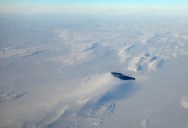Scientists Now Know Why A Huge Hole Opened Eight Years Ago In Antarctic Sea Ice

Even if some people don’t like to acknowledge a little thing called climate change or global warming, there is no doubt that it exists.
Still, when a giant hole opened up in Antarctic sea ice eight years ago, scientists wanted to know why.
The hole in Antarctica’s Weddell Sea was twice the size of Wales, and returned again a year later.
Now, scientists are laying the blame at least partially at the door of a rare form of salt transportation.

It’s common for areas of open water to appear within sea ice; it’s called a polynya.
They wanted to know why this polynya, though, was not only so large, but why it consistently appeared in the same place. It wasn’t because of an early thaw or anything so simple, so they set out to learn more.
Scientists used elephant seals to do their research, strapping scientific equipment to their heads and following them around digitally. Initially, researchers attributed the polynya to a combination of factors like unusual ocean conditions and a huge storm.
Now, though, they have added a few other elements to the mix.

One of those things is the Weddell Gyre, a circular current that was unusually strong between 2015 and 2018. It caused a deep layer of warm salty water to rise to the surface, says University of Gothenburg professor Fabien Roquet.
“This upwelling helps to explain how the sea ice might melt. But as sea ice melts this leads to a freshening of the surface water, which should in turn put a stop to the mixing. So, another process must be happening for the polynya to persist. There must be an additional input of salt from somewhere.”
Evidence from the seal cams and some autonomous floats says that salt rose in turbulent eddies as the current flowed over the Maud Rise, an undersea ridge.
The polynya did not form directly over the peak of the rise, instead centering over its northern flank. The study authors say this is down to the Ekman transport, where water moves at right angles to the direction of the wind.
In fact, it’s the key, says co-author Professor Alberto Naveira Garabato.
“Ekman transport was the essential missing ingredient that was necessary to increase the balance of salt and sustain the mixing of salt and heat toward the surface water.”

So this time, climate change was likely not to blame, but they still might be related.
Ice insulates the ocean from the atmosphere, blocking the transfer of energy. Without it the exchange increases, as does carbon dioxide.
The polynya, then, could lead to additional warming.
“The imprint of polynyas can remain in the water for multiple years after they’ve formed. They can change how water moves around and how currents carry heat towards the continent. The dense waters that form here can spread across the global ocean.”
There haven’t been any recurring polynyas in the area since 2018, despite conditions being present.
If you thought that was interesting, you might like to read about a second giant hole has opened up on the sun’s surface. Here’s what it means.

Sign up to get our BEST stories of the week straight to your inbox.




